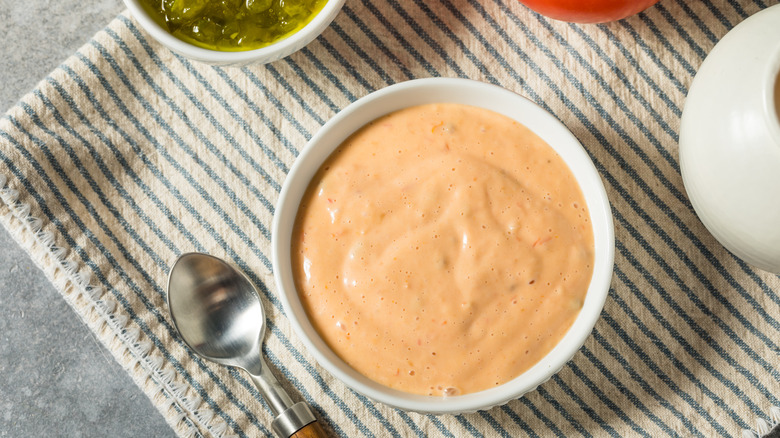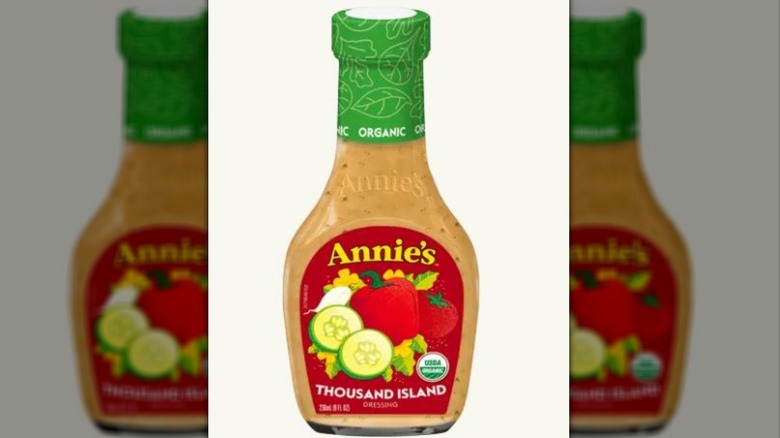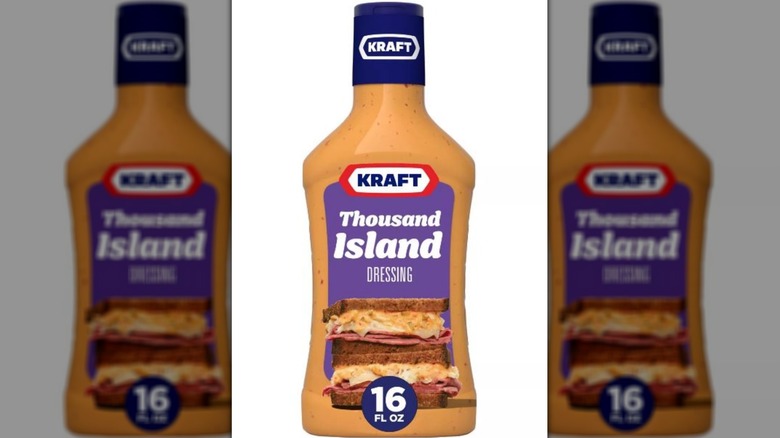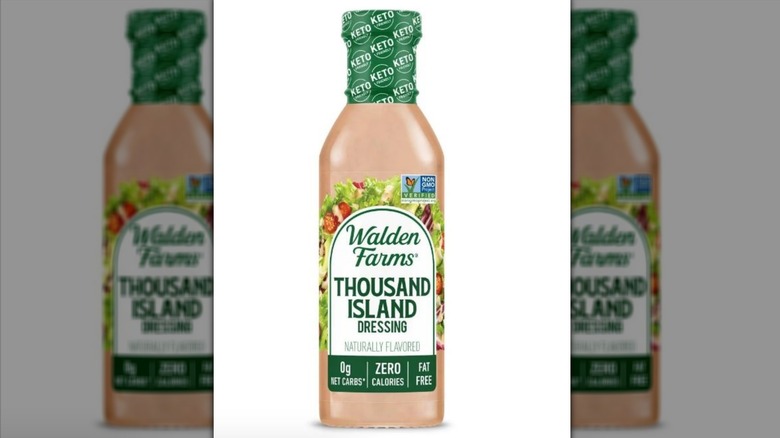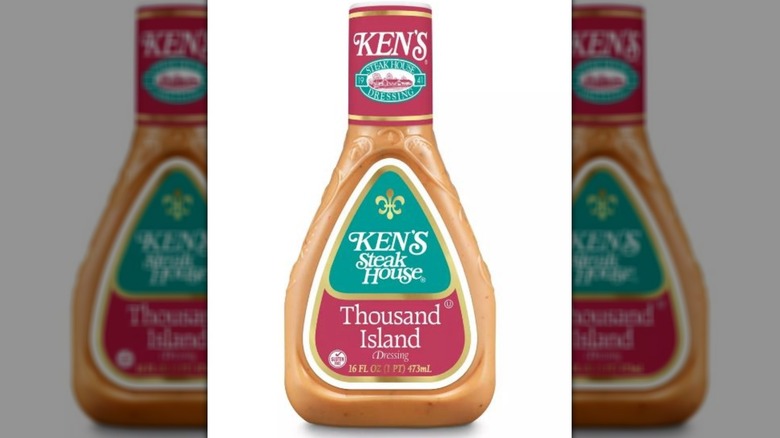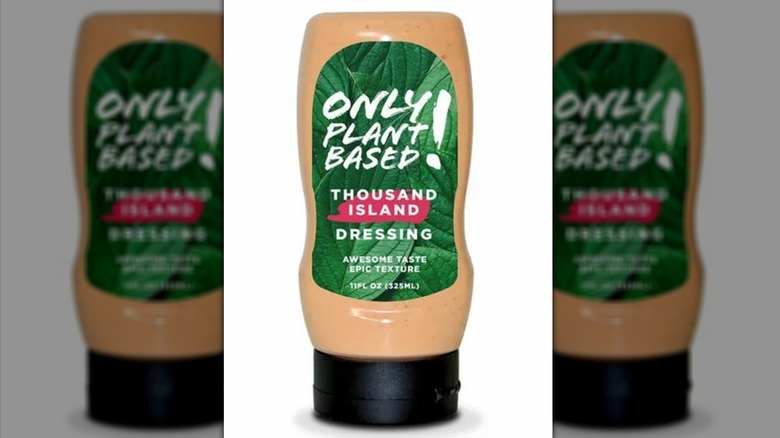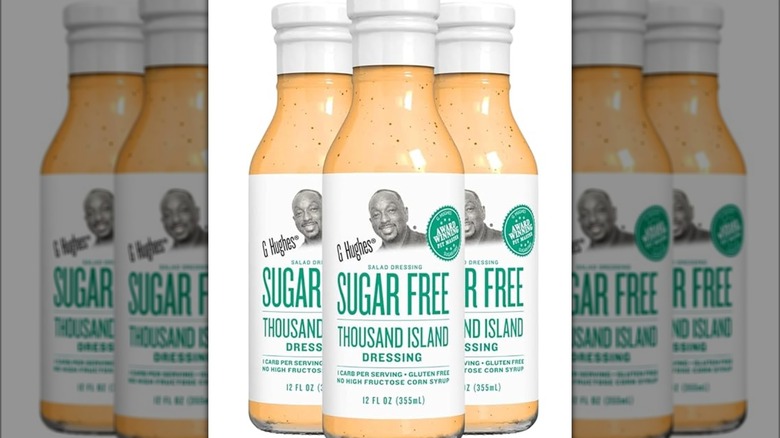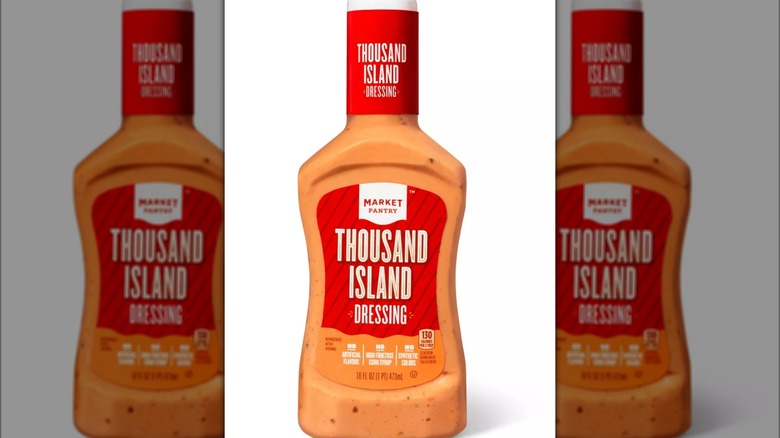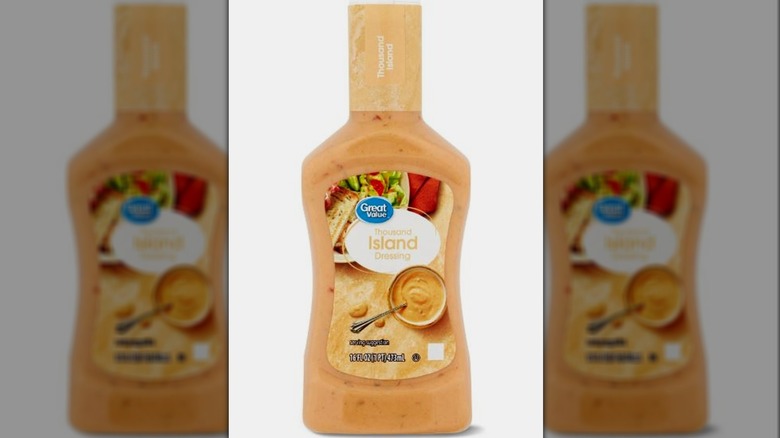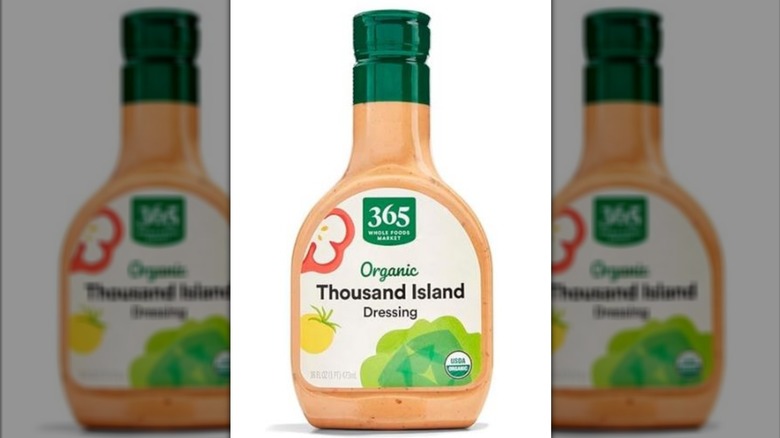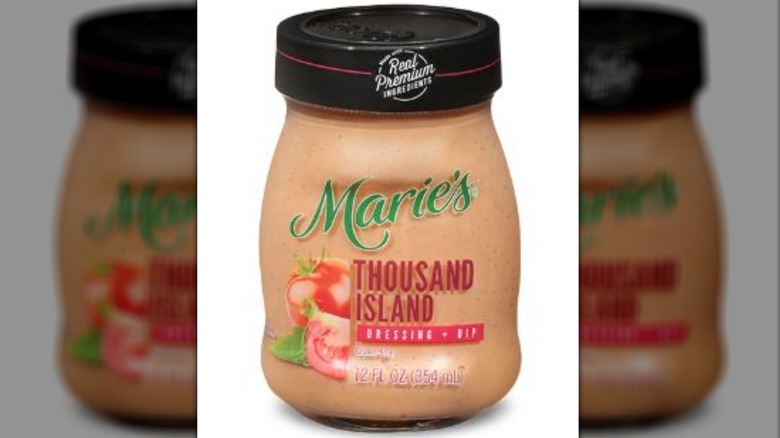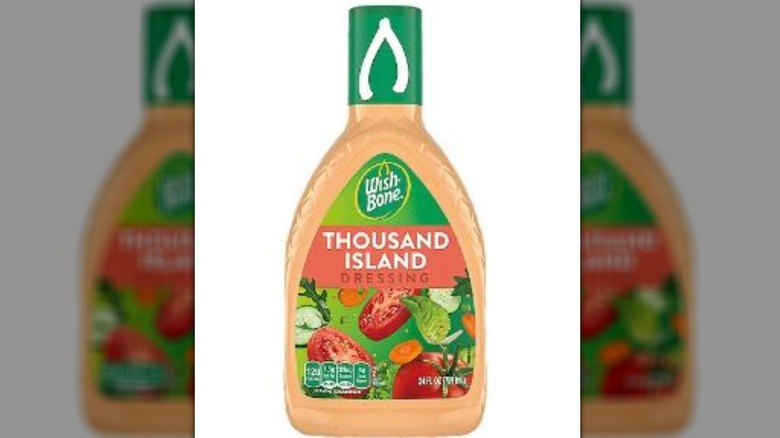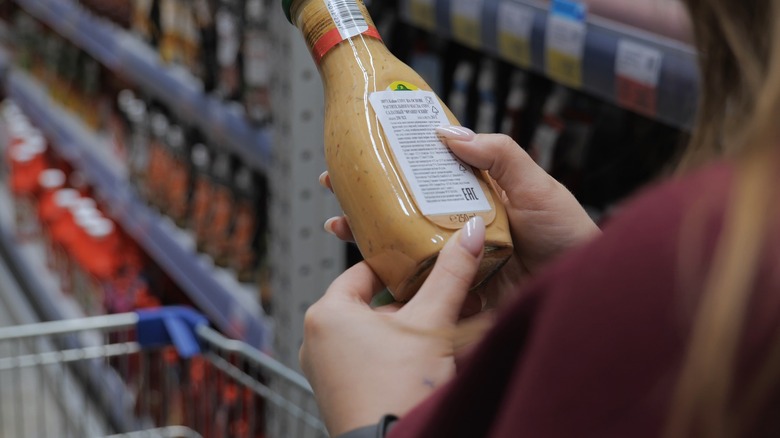4 Healthiest And 7 Unhealthiest Store-Bought Thousand Island Dressing
We may receive a commission on purchases made from links.
Let's be real. Salad dressing is one of the most delicious toppings — and it can be great for more than just salad. One of many people's favorites is thousand island dressing. With its rich and creamy flavor, it tastes great on anything from a kale salad to a hamburger. Many brands have their own twists on thousand island dressing. Some brands taste better than others, some are healthier, and some are neither.
Not all salad dressings are creamy, and that's where thousand island dressing is a bit more unhealthy than Italian dressing or vinaigrettes. Most thousand island dressings are made with mayonnaise, which is high in fat. Fat isn't necessarily unhealthy; however, it's a macronutrient that can quickly add up throughout the day. Drinks, dressings, and condiments are some of the common culprits that cause people to eat too much fat within a day. The Food and Drug Administration (FDA) recommends a maximum of 80 grams of fat consumed per day, and no more than 25 of those grams should be saturated. This is for someone on a 2,000-calorie diet — so these numbers fluctuate for each individual.
There are other things to consider as well, like total amounts of calories, sugar, sodium, and ingredients used in the dressings. We combed through a variety of brands that make thousand island dressing and curated a list of the healthiest and not-so-healthy options.
Healthy: Annie's Organic Thousand Island Dressing
The Annie's brand offers many healthy options for pantry staples. From canned pastas and macaroni and cheese to salad dressings, all of the food from Annie's is made organically with the health of both the planet and the consumers in mind. We were pleased to see that Annie's Thousand Island Dressing is on the healthier side of the spectrum.
Now, because this dressing is organic, it already gets points on our healthy list. Eating organically can reduce the exposure to harmful pesticides and other chemicals that can affect our health. Now, when looking at the ingredients for Annie's dressing, we can see that it isn't long with too many unfamiliar words. It is mainly made with apple cider vinegar, soybean oil, relish, tomato paste, sea salt, egg, mustard seed, and other vegetables and herbs to add flavor.
Overall, there are 90 calories in 2 tablespoons of Annie's dressing. There are 7 grams of fat, which most likely come from the egg. We do have to point out that there are 5 grams of added sugar (organic cane sugar) and a whopping 360 milligrams of sodium — which we do wish were lower. We will forgo those numbers considering the ingredients are organic and clean and the overall product is lower in calories than others on this list. The dressing must taste great as well because it has a rating of 4.3 stars on Amazon, with customers enjoying the flavor.
Unhealthy: Kraft Thousand Island Dressing
Oh, Kraft. This brand carries many nostalgically delicious items, like Kraft macaroni and cheese, which goes through an extensive process to achieve that taste we all know and love. Unfortunately, the Kraft Thousand Island Dressing made its way onto our unhealthy list. The ingredients include a few items that show that this dressing is processed. Xanthan gum, potassium sorbate, citric acid, and calcium disodium EDTA are all additives used to help preserve the dressing. They are indeed considered safe (or the FDA wouldn't allow them); however, they aren't necessary. The more unnecessary things we put in our body, the more we risk reactions like abdominal discomfort or a general feeling of unwellness.
In 2 tablespoons of Kraft Thousand Island Dressing, there are 13 grams of fat. That is nearly 17% of the FDA's daily recommended amount. The 2 grams that are saturated make up 10% of the FDA's daily value. Just getting that amount from dressing is quite a lot, especially since dressing is almost always eaten with other foods — foods that probably have fat in them as well. Each serving has 130 total calories, which is on the higher end for a dressing. Plus there are 250 milligrams of sodium.
Now, don't let yourself get swayed by the positive reviews about the delicious taste of the dressing on the Target website. Just keep your wits about you, and know that there are healthier options out there that still taste just as great.
Healthy: Walden Farms Thousand Island Dressing
The Walden Farms brand has been around since 1972 and carries calorie-free items like salad dressings, dips, coffee creamers, condiments, and more. The aesthetically pleasing packaging tends to draw people in, and the fact that the items are zero calories gets consumers even more intrigued.
If you're wondering how a dressing can have zero calories, you're not alone. The Walden Farms Thousand Island Dressing is made with some organic ingredients, like apple cider vinegar and dried garlic. There are other flavorings like spices, juice concentrates, and vegetables. Note, it does contain some additives, including xanthan gum, microcrystalline cellulose (an anti-caking agent), and propylene glycol alginate. Now, we admit, it's still confusing how this dressing can be zero calories. It's because the dressing is mainly made with vinegar and natural flavorings. It also has zero fat, zero cholesterol, and zero sugar. Its nutrition label lists 200 milligrams of sodium.
You may also be thinking that since this dressing is zero calorie, it must not taste great. To our surprise, a lot of consumers online liked it. One Amazon customer shared, "When you are tracking your macros and you don't have much or any fat left in the day, this no calorie dressing comes in handy ... It's got a little bit of a tangy flavor and is slightly sweet. I find it pretty tasty." If you're looking for ways to cut excess calories, this dressing would be a great choice!
Unhealthy: Ken's Steakhouse Thousand Island Dressing
Ken's Steakhouse is a popular salad dressing brand that sells over 60 flavors. When it comes to great-tasting dressings, Ken's Steakhouse knows exactly what it's doing. Whether these salad dressings are healthy or not, however, is another story.
The Ken's Steakhouse Thousand Island Dressing earned itself a spot on our unhealthy list. Right off the bat, we saw that there are 140 calories in a 2-tablespoon serving of the dressing. Most of the calories come from fat — 14 grams to be exact. That is 18% of the FDA's recommended daily amount. As for saturated fat, there are 2 grams, which is 10% of the FDA's daily recommended value. There are 240 milligrams of sodium and 4 grams of sugar, of which 3 grams are added sugars. The FDA recommends no more than 2,300 milligrams of sodium per day and 50 grams of added sugar per day. These are numbers that can sneak up on you, and when you are consuming significant amounts in salad dressing — you may not realize the overall effect.
The ingredients list is a bit long and includes xanthan gum, propylene glycol alginate, potassium benzoate, and potassium sorbate, so be sure you become educated about common food additives. Since this dressing already contains a high amount of calories from fat, puts a dent in your daily sugar and sodium count, and has unnecessary additives, we think you should skip Ken's Steakhouse when it comes to thousand island dressing.
Unhealthy: Only Plant Based! Thousand Island Dressing
The Only Plant Based! company uses inspiration from the world's plant-based cuisines to create its products. It sells condiments like mayonnaise and creamy dressings, and from just the bottles themselves, they all look pretty tasty. The company's Thousand Island Dressing initially seems low calorie; however, when digging a bit deeper into the nutrition information, we discovered that it isn't the healthiest.
Most dressings list their serving sizes as 2 tablespoons. Only Plant Based! lists its serving size as half of that amount. We were initially fooled by the nutrition panel, thinking that this dressing was only 70 calories. Realistically, though, how many people are only using a tablespoon of salad dressing? That is a very small amount. To have an equitable comparison for our list, we used 2 tablespoons. That means this dressing is about 140 calories. While translating the measurements to a normal serving size, we also saw 14 grams of total fat, which is 18% of the FDA's daily recommended value, and 150 milligrams of sodium.
While plant based foods are here to stay, that doesn't always mean they are healthy for you. This dressing also contains a few additives and preservatives, which again aren't necessary. The main ingredient in the dressing is rapeseed oil, which is a genetically modified and highly processed oil. Many people think that something that is plant-based will be completely natural, and this is the perfect example to show that it isn't always true.
Healthy: G Hughes Sugar Free Thousand Island Dressing
The G Hughes brand focuses exclusively on sugar-free sauces. It makes barbecue sauce, ketchup, honey mustard sauce, steak sauce, and more. You name it — G Hughes has made it, including its own Thousand Island Dressing. Knowing immediately that this dressing was sugar free, we were curious to see how the rest of the nutrition facts stacked up.
In 2 tablespoons, this dressing has only 60 calories. That's less than half as much as several of the other brands that we've looked at so far. As for fat, there are only 6 grams total, with just 1 gram of saturated fat. It also has 270 milligrams of sodium. With zero added sugars, one might wonder how the dressing tastes. The good news is that the G Hughes Sugar Free Thousand Island Dressing is rated a solid 4.5 out of 5 on Amazon. Many people commented that this dressing isn't watered down like other lower calorie dressings and still tastes great even though it's sugar free.
Now, what ingredients are used to make a successful low-calorie and zero-sugar dressing? It has vegetable oil, vinegar, tomato paste, egg yolk, cucumber, spices, and other known ingredients. We do have to mention that there are some preservatives, like sodium benzoate and potassium sorbate; however, we can look past those for the fact that the nutrition numbers knocked it out of the park.
Unhealthy: Market Pantry Thousand Island Dressing
Market Pantry is one of Target's own brands, and many people depend on it for affordable prices. A 16-ounce bottle of the Market Pantry Thousand Island Dressing is $2.49 — and that's a New York City price, so it's most likely cheaper elsewhere. Of course, there's a downside, and it's that this dressing isn't the healthiest.
There are 120 calories in a 2-tablespoon serving. As for fat, this dressing has about 12 grams (15% of the daily value) and 2 grams of saturated fat (9% of the daily value). There are also 260 milligrams of sodium. Now, there's a reason the FDA has recommended limits for how much fat and sodium you should consume in a day. Both of these, in excess, can lead to heart health issues that nobody wants. It's important to look out for high amounts of fats and sodium that can be hidden in our food. In just two tablespoons, the Market Pantry thousand island dressing has quite a lot.
The ingredient list didn't impress us very much, either. There are some okay ingredients in there, like tomato puree, spices, egg yolk, and vinegar. These are in basically every thousand island dressing and help create its characteristic taste. There are also other ingredients, like sugar (4 grams per serving) and multiple preservatives that simply aren't needed. Although you can get this dressing for a cheap price, we wouldn't recommend grabbing it if you're trying to be health-conscious.
Unhealthy: Great Value Thousand Island Dressing
Hands down the most affordable brand on our list is Great Value from Walmart. It sells a 16-ounce bottle of thousand island dressing for $1.97. Unfortunately, there are many products sold by Great Value that aren't the healthiest, and its thousand island dressing is one of them.
In two tablespoons of dressing, there are 130 calories. There are 12 grams of fat and 2 grams of saturated fat (an amount we've commonly seen among the unhealthy dressings), making a dent in your daily amount recommended by the FDA at 15% and 10%, respectively. These are significant amounts for the serving size you're getting. There are also 280 milligrams of sodium, which is 12% of the FDA's daily recommended value.
Even though 2 tablespoons is the average serving size for salad dressing — it actually isn't that realistic. Two tablespoons is less than what goes into a shot glass, which isn't very much. If you're using thousand island dressing as a sauce for a burger or sandwich, two tablespoons makes sense. However, if you are using a thousand island dressing on your salad, two tablespoons isn't going to cut it for a lot of you. It's more realistic to double or even triple that amount. Keep that in mind when choosing your thousand island dressing because the numbers you're reading on the label might not really be what you're realistically consuming.
Somewhere in the middle: Whole Foods 365 Thousand Island Dressing
With its interesting history, the Whole Foods 365 brand tends to have many healthy options. We were hopeful when researching the Whole Foods 365 thousand island dressing but ended up feeling a bit unsure. This dressing falls directly in the middle of healthy and not healthy.
In two tablespoons, Whole Foods 365 Thousand Island Dressing has 100 calories. Many of the unhealthy brands we looked at had 120 calories or more, and the healthier brands we saw had about 80 calories or less. In total, the dressing has 10 grams of fat with 1.5 of those grams being saturated. That's about 13% and 8% of the FDA's daily recommended amounts, respectively. Overall, those numbers aren't great, but they're as bad as some others, either.
There are 260 milligrams of sodium per serving, which is 11% of the daily value. This number could definitely be lower, and we consider this on the higher end for thousand island dressings. However, there are only 2 grams of added sugars — which even some of the healthier brands had a bit more than that. There are a lot of organic ingredients in this dressing, which is a plus. However, the ingredients list is long and includes a few preservatives. You could do worse than this dressing, but based on our list, you could also do a lot better.
Unhealthy: Marie's Thousand Island Dressing
Marie's is a brand that comes off as a tad luxurious, with its short glass jars and its elegantly designed logo. Luxury doesn't always equate to health, however, and that holds true for Marie's Thousand Island Dressing. In two tablespoons, this dressing has one of the highest amounts of calories we've seen — 160 calories to be exact. There is also quite a lot of fat, 16 grams, which is 21% of the FDA's daily recommended amount. The saturated fat is high too, with 3 grams, which is 15% of the FDA's recommended daily value. Those numbers are incredibly high for something that is just a topping or condiment to a meal. It also has 220 milligrams of sodium.
The ingredients that make this dressing higher in fat and calories have to be the soybean oil, egg yolks, and sour cream. We haven't seen sour cream listed on other dressings' ingredient lists. It most likely makes it taste incredibly creamy and tangy; however, it also racks up the amount of fat in a serving. There actually aren't many preservatives or concerning ingredients in this dressing, which is perhaps what makes it higher quality and more expensive. Unfortunately, if you choose this dressing, you will really be adding a lot of calories and fat to your meal that aren't exactly necessary.
Unhealthy: Wish-Bone Thousand Island Dressing
Many people are familiar with Wish-Bone, a brand that graces the shelves of many grocery stores. Its dressings are loved and depended on by many; however, we unfortunately have to add Wish-Bone Thousand Island Dressing to our unhealthy list. Two tablespoons of dressing has 120 calories. With 11 grams of fat and 1.5 grams of saturated fat, this dressing is definitely on the fattier side. It also has 4 grams of sugar. One of the most concerning things about this dressing, however, is the sodium count. The Wish-bone Thousand Island Dressing contains a whopping 320 milligrams of sodium, which is 14% of the FDA's daily recommended value.
The sodium number alone is quite a lot — you could easily surpass your daily amount of sodium in one meal. Many people use thousand island dressing for a Reuben sandwich, which is made with corned beef. A serving of corned beef has over 800 milligrams of sodium, and with toppings like cheese and thousand island dressing, you're basically having a salt sandwich!
If you are using the dressing as a salad topping, remember that it's likely that you will double the serving size to be able to coat your dressing successfully. That would get you to 28% of the daily value of sodium — just for a salad. It's better to choose a dressing that has a lower amount. Making small switches like that can positively impact your health in a large way.
Methodology
When considering which thousand island dressings were healthy or unhealthy, we considered a few factors. Calories as well as the amount of fat, saturated fat, and sodium were our main indicators. We combed through many grocery store websites to see which brands were on the shelves and to check their nutritional information. We also considered ingredients, as some dressings are made organically, and some are incredibly processed. Taking all of these factors into account, we were able to make this comprehensive list. Please note that any prices mentioned were accurate at the time of publication and are based on one regional area.
